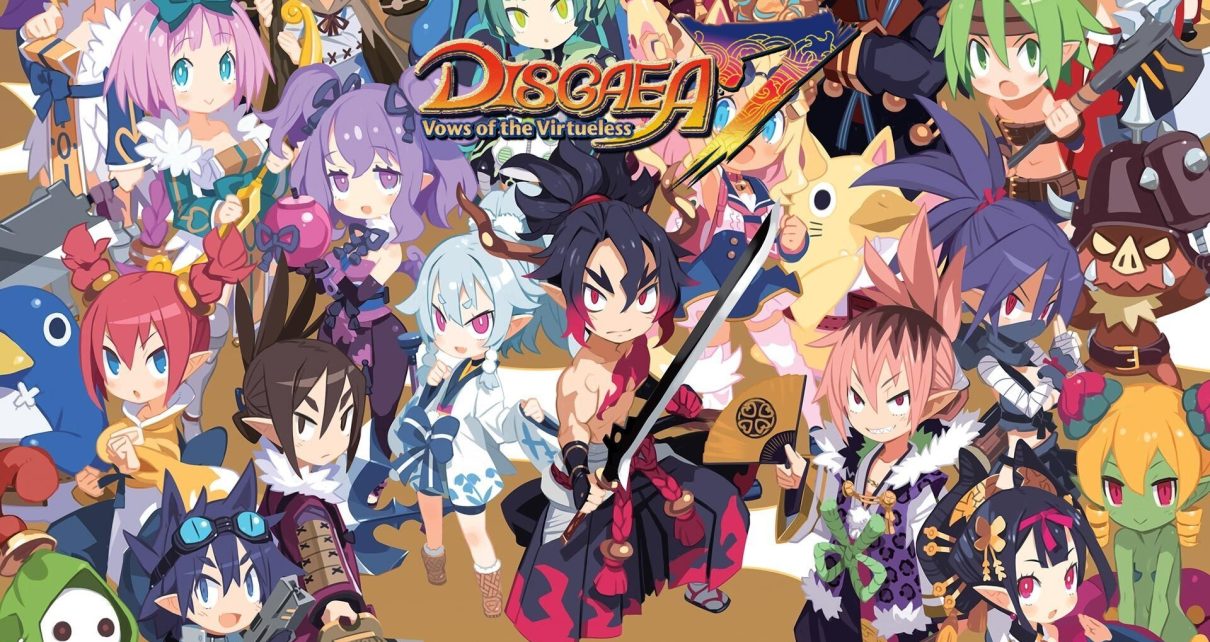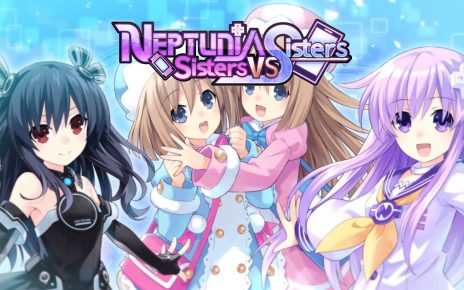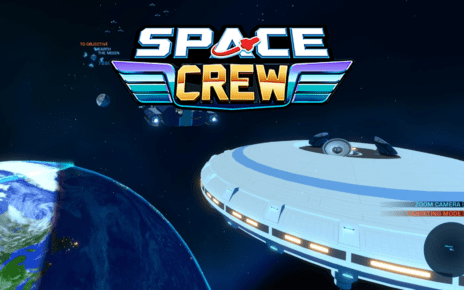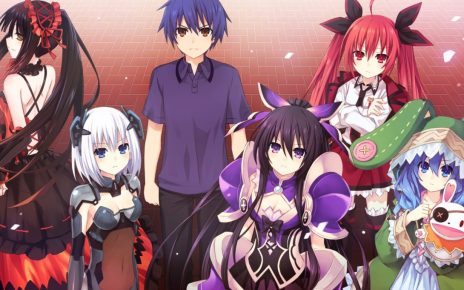Disgaea 7: Vows of the Virtueless is the latest entry in the long-running Japanese SRPG series, Disgaea. It’s only been a couple of years since the launch of Disgaea 6, which received something of a mixed response from series fans, so you may be wondering what Disgaea 7 brings to the table to entice players back in so soon. Well, I’ve spent about forty hours with the game so far, in which I’ve finished the main story and a good chunk of the endgame content, and whilst I’m eager to play more I’m taking a little break to talk about it here.
Disgaea 7 is developed by Nippon Ichi Software, and published by NIS America. The game will be released on Nintendo Switch, PS4, and PS5 on October 3rd in North America, October 6th in Europe, and October 13th in Australia and New Zealand. On Steam the release date is October 3rd worldwide.

BooShido
Disgaea 7’s narrative takes place in Hinomoto, a series of Netherworlds themed around Feudal Japan. Hinomoto was once defined by Bushido, a code of honor that is perhaps ill-fitting for the demonic inhabitants of the Netherworlds. Hinomoto has changed in recent times however, with the arrival of Demon Admiral Opener. Opener has subjugated Hinomoto, installed a corrupt Shogunate, annihilated the Bushido code, and in general just been a bit of an arsehole.
Our two protagonists, Fuji and Pirilika, are almost polar opposites to one another. Fuji is a Hinomoto native, and a ruthless and pragmatic demon. He claims to be allergic to empathy, so allergic in fact that any experience of compassion causes him to vomit blood. Sustained exposure to genuine care or affection may well see him off. Pirilika on the other hand is a naive, earnest, and obscenely wealthy girl who has come to Hinomoto to immerse herself in its rich culture. She is a dyed-in-the-wool weeb who idolizes the concept of Bushido and is convinced of the inherent goodness of others.
Our two oddballs end up working together to overthrow Opener and defeat the corrupt Shogunate. Pirilika wants to restore Hinomoto to the idealized land of honor that she became obsessed with, and Fuji agrees to work as her bodyguard in order to clear his multi-billion HL (the universal currency of the Disgaea series) debt. The off-the-wall humor that’s become a staple of the series is executed brilliantly here. The contrasting dynamic between Fuji and Pirilika is great comedic fodder, and things only get better as the cast expands.

Ditzy Demons
Disgaea’s characters have always been a highlight for me, and Disgaea 7 has been no exception. The game manages to deliver on some impressive comedic highs, whilst also carrying some emotional weight that gives depth to the characters in the latter half of the narrative. The short skits that play between game chapters were excellent, as were the stage cutscenes. The narrative paces itself perfectly. There’s no real downtime and I never found myself becoming bored with the character interactions, which is something I have felt in prior entries in the series.
Not every character is a hit, of course, but for the most part the cast is delightful. Pirilika stole the show somewhat for me, seeing this relentlessly positive character have their nonsense dreams of Hinomoto constantly undercut was hilarious. A relentless belief in innate kindness and generosity can be exhausting, but committing to it in the face of such obvious contradictions makes it pretty charming. Those characters that are on the weaker side like Yeyasu, Hinomoto’s philanderous puppet Shogun, are still engaging and somewhat likable, but just struggle to land as well as personality powerhouses like Pirilika.
When things get serious, or at least marginally less silly, the character writing sticks the landing surprisingly well. Working emotional conflict and tragedy into a comedy is tough, and in my experience it rarely goes well. In Disgaea 7 though, confronting the emotional heart of the story never felt unnatural. Characters didn’t discard their outrageous personalities, they were integrated into the more heartfelt moments. The strength of the character writing, and the commitment to the bit, gave Disgaea 7’s writers license to do just about anything they wanted with the narrative. I was fully on board with the direction they decided to go.

Demonic Refinement
Disgaea is a series somewhat defined by abundance. Disgaea 7 has a lot going on in the gameplay department, and so there is a lot to discuss. I want to start with a general appraisal, a sort of mission statement, and then expand on that with examples and details. Here’s the bottom line, Disgaea 7 is a refinement of systems and ideas from previous titles. Some of the leaps made in Disgaea 6 have been reigned in, and some of the best elements of Disgaea 5 have had their edges shaved down a bit. Some new ideas have been mixed into the pot as well, but more in an effort to perfect the formula rather than to add complexity.
Disgaea 7 won’t please everyone, but I think the vast majority will appreciate what’s been done here. There are some changes that I’m not too enthusiastic about, but they aren’t deal-breakers and that’s what I expect will be most people’s experience. If you’re coming in right out of Disgaea 6 then you might find the game a bit more inaccessible than that experience, but if you’ve played titles prior to 6 you should have no trouble.
The auto-battle feature added in Disgaea 6 is still present, but it has been heavily restricted. Auto-battle can now only be used in story stages you’ve cleared once, and it can’t be used at all in the item world. There is also now a cost for auto-battle, a new fuel resource which is earned at a rate of one unit per stage cleared. One unit converts to one turn of auto-battle. There are some improvements to the formula that make this change feel a bit less drastic which we’ll talk about later. Regardless, this is likely to be the most polarizing change in Disgaea 7. Auto-battle has been a point of division for series fans so how you feel about this will depend on which side of that you find yourself on.

Gachapon Healthcare
One of my favorite changes made in Disgaea 7 is the overhaul of the Netherworld Hospital, where you’ll heal your units after battle. Previous Disgaea titles had a system where healing characters would earn points that slowly unlocked a series of milestone rewards. This was always a nice idea, but to me always felt insubstantial. Disgaea 7 builds on this system with some interesting additions that made a huge impact on my playthrough.
In Disgaea 7 when you heal your units you will gain RP, a currency which you can then spend on the new evil-gacha. This system is a ton of fun. It’s another tool you can use to break the game open a bit, which is my favorite thing to do in Disgaea. The evil-gacha can drop a number of useful rewards. You can pull gear with great modifiers, juice bar extracts for character growth, HL, and more. The gacha has multiple tiers that you will unlock the more you play it, and there are some fun ways to exploit the system to maximize your growth.
The evil-gacha provided all the gear I used for the main story, and was an integral element of my early grinding method. It’s really useful, but also just fun. And evil-gacha isn’t the only addition to the Netherworld Hospital. You can also use RP on wickedhancements, temporary buffs to your character’s stats that you can customize and compound. It’s similar to the curry system from Disgaea 5, but streamlined a fair bit. I didn’t find myself using this system too much, as I always preferred to dump RP into the gacha, but it’s a nice little bonus.

Fighting For Freedom (And XP)
Disgaea 7’s combat is as excellent as it’s ever been for the series. What I have always loved about Disgaea games is the ability to customize your team, try out fun new setups and strategies, and exploit the game’s systems to trounce your enemies. Disgaea 7 nails the aspect of customization and player freedom, whilst also providing a tightly designed playground to mess around in. You have access to 45 character classes, including 4 new classes for the series, the Big Eye, the Bandit, the Maiko, and the Zombie Maiden. The new additions are a fun bunch, and certainly add some new possibilities for your team setup, but I wasn’t terribly impressed by them overall.
Stage design is a lot tighter here than in Disgaea 6. Main story stages provide interesting obstacles and challenges that require some adaptation from the player, whilst still providing plenty of room to experiment. In general it feels as though the focus has been pulled inward. Maps are tightly designed and sprawl has been reduced. The UI is nice and clear, whilst still containing an abundance of information, and combat progresses at a nice pace (which can be sped up massively with some unlockable settings).
One change that I don’t love is the overhaul of the bonus system for stages. In lieu of a bonus gauge that is filled by performing combos or clearing geo-panels, you now have static missions. These missions are decently varied, including things like deploying a limited number of units or finishing the stage in a set number of turns, but they can make your initial playthrough feel a little restricted if you want to get the best result possible. It’s definitely a lot less vague than the bonus gauge in previous games though, which is nice for newcomers.

Gigantama- Err, Jumbification
So what are the big changes to combat in Disgaea 7? Well the big new feature you may have seen if you’ve been following the marketing is jumbification. As you fight a rage meter will fill, and once it’s full you can jumbify your units, turning them into gargantuan units that loom menacingly over the stage. Jumbification looks great, it’s a fun concept, and it brings some new options and considerations to the table.
Jumbified units activate a map-wide effect that can change the flow of combat on the ground, and they can also dish out powerful area attacks that can turn the tide in your favor. The effects offered by jumbification require some consideration for the player, as they affect every unit on the map, ally or enemy. Higan for example, one of the unique units you’ll recruit through the story, nullifies all magic attacks whilst jumbified. This could be a great boon if you need to blunt some enemy mages for a few turns, but it also leaves you with only physical damage output. Add to this that enemies can also jumbify and you’ve got some jumbo considerations to make.

Hell mode is another new feature that provides some great benefits for the player. Unique units in possession of an infernal treasure (powerful weapons that are tied to the story and cannot be transferred) can activate Hell mode to provide themselves with some fun buffs. Higan again for an example, can take three actions per turn. Hell mode is charged differently depending on the character, some will have to defeat enemy units, some will have to sustain a number of attacks, and some will have to do a certain amount of healing. I liked the implementation of Hell mode, but it feels a bit overshadowed by the spectacle of jumbification.
Some things that aren’t new, but are changed from Disgaea 6, are the return of weapon skills which opens up your customization options a bit, the level cap has been set back to 9,999 and stat caps have been reduced in line with that, and XP is no longer shared at the end of a stage but earned individually in the middle of combat as it was in previous entries. The juice bar remains however, so catching up units who fall behind isn’t too daunting. Magichange is still sadly MIA, sorry folks. Overall I’m neutral to positive on these changes, I like the return of weapon skills, but I don’t have any strong feelings as far as level cap and stat scaling are concerned.

Item World, Reincarnated
Item world has seen some significant overhauls in Disgaea 7. Previous titles had you diving through an enormous amount of floors to grind out your item’s stats, and it was fun but in my experience kind of grueling. In Disgaea 7 the item world has been reined in, with the floor limit now capped at ten for common items, twenty for rares, and thirty for legendaries. This has transformed the item world into a much more engaging experience.
Some changes have been made to the innocent system. Innocents are little dudes who live in your items and provide a range of effects—in Disgaea 7 they only provide stat bonuses. More interesting effects have been moved to the item property system. Item properties can do all sorts of fun things, from adding a chance to parry with some weapon types, to changing the elemental property of your basic attacks.
The big addition to items, and the item world, this time around is item reincarnation. Now you can reincarnate an item after clearing all of its floors, earning you a permanent base stat increase and a chance to change its properties and form. Once you’ve reincarnated an item you can explore it all over again to push it even further. It will take a lot more testing and experimentation than I’m capable of to work out the limits of this system, but there are a lot of interesting possibilities even if you aren’t optimizing it perfectly. Items can evolve into better versions of themselves, and they can even evolve into entirely different items.

For The Newcomers
A question I have with every Disgaea title is: “how would this perform as someone’s first Disgaea experience?”. Disgaea 7 is certainly more accessible than older titles, but I’m still not sure if it’s great for a first-timer. There is a lot of assumed knowledge of systems from previous titles, and the sheer amount of those systems could easily be overwhelming. That said, the quality on display and the holdover accessibility options from Disgaea 6 do offer a nice buffer.
If you have no prior experience or expectations for Disgaea, then I think you’d experience this as an engaging SRPG, with a ton of customization, and a steep learning curve. It’s brilliant, but it requires a fair bit of effort to get acclimated with, which to be fair is a statement that applies to almost every game in the series to some degree.
I think if you’re willing to look outside of the game for assistance, and you’re okay with progressing at a slower pace and taking time to familiarize yourself, then this could work as an onboarding point. The issue I could see is that if you went from Disgaea 7 to earlier titles you’d be experiencing an inverse progression of quality and refinement. Going from Disgaea 7 to 5 for example would be a pretty sharp drop in quality in terms of narrative and character writing.
If this is your first Disgaea experience or you’d just like to make sure you’re heading in the right direction, our Disgaea 7 Hints and Tips article might be a good starting point.
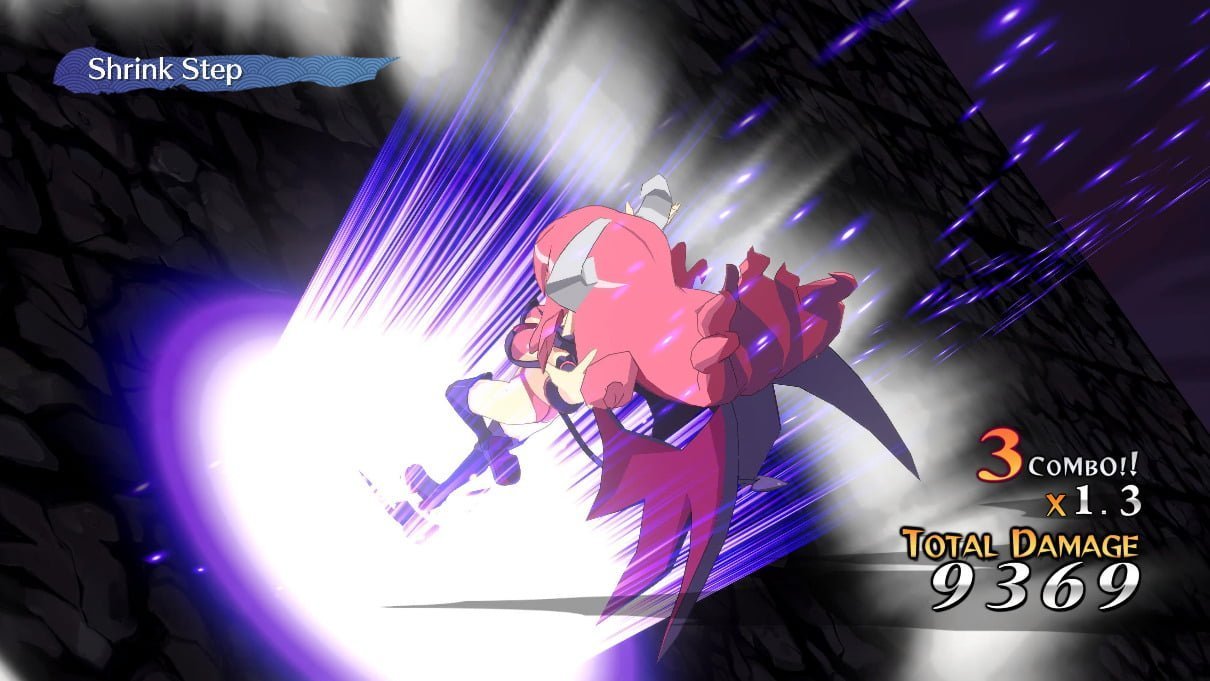
PvP (Kinda)
One of the more unusual additions to Disgaea 7 is a PvP mode, of sorts. This isn’t simultaneous combat between two players, but more akin to the kind of PvP you might see in some gacha titles where players set up teams and you face off against an AI controlling that team on the other player’s behalf. What makes this interesting in Disgaea 7 is that you write the AI instructions yourself.
This is where auto-battle is still shining. You create a team according to a set of rotating tournament rules. The examples I saw during the review period were female units only, and male units only. I assume as time goes on these restrictions will get a little more advanced and interesting. You can set up the DI (Demonic Intelligence) that governs how your units will behave in their auto-battle against the enemy, and I can see some fun competition to be had here.
I didn’t get much of a chance to play around with PvP ahead of release. The pool of players was limited to those playing for review and as a result the power balance was a bit all over the place and for a while there were only a few people participating. That said from what I’ve seen I think this has a chance to become an engaging part of the endgame experience, once you’ve cleared everything the game has to offer what’s left but to take your insanely optimized team and fight it out with other Disgaea fans? There are concerns I might have around balance, but it will take time to see how things settle. Hopefully the developers keep an eye on things and work to keep the multiplayer populated and rewarding.

2D Or Not 2D
Disgaea 6 courted a fair bit of controversy by shifting the series to 3D. There was a great deal of charm in Disgaea’s 2D battle sprites and animations, and I do think 6 was something of an artistic step-down. That said, I’m not principally opposed to the switch to 3D, and I have to say Disgaea 7 is a gorgeous game in all respects. 3D models have been improved upon greatly here, and animations have a lot more going for them too.
I was delighted by the amount of personality and humor injected into some characters’ skill animations, like Pirilika’s sneaky selfie after her maximum ray special. There is so much vibrancy and color in every element of Disgaea 7’s visuals, the characters and environments are both bursting with creativity and life. I think a more cohesive set of Netherworlds has allowed for much stronger artistic direction here.
The visual novel segments look great too, though they can feel a bit static which is a shame when contrasted against the game’s off-the-wall tone. I would also add that whilst Disgaea 7 has some of my favorite character design work of the series, some characters do feel a bit generic. Yeyasu for example feels quite plain in comparison to the rest of the cast, his design comes across as pretty one-note.

Runs Like a Kunoichi
Before I wrap up the graphics section, a quick word on performance. I played Disgaea 7 on Playstation 5 and I didn’t experience any noticeable frame drops or slowdown. The game looks beautiful and runs perfectly. I spent some time with the demo version for the Nintendo Switch, and took a look at some performance feedback from those who’ve played the Japanese release and my fellow NookGaming writer who played it at the NIS America Press Event, and I can say that performance there is a massive improvement over Disgaea 6. There are options for performance and image quality available, so if you do experience performance issues you have some options to offset it.
There can be a degree of slowdown in combat on Nintendo Switch as the AI makes its moves and turns resolve, but I don’t think it’s too noticeable unless you’re directly comparing it to the PS5 release. Of course things may slow down beyond the demo as stages get more complex, but most feedback I’ve seen indicates performance remains solid in the full release. There is of course a tradeoff in visual fidelity for the Switch port, but that is to be expected and the game still looks fantastic. You can’t really go wrong no matter which platform you decide to pick it up on.

Hinomoto ‘n Rock
Disgaea 7 comes with dual English and Japanese voice acting. Both vocal casts are strong, but I spent most of my time with the English dub. I recommend trying out both options and seeing which you like best. The cast does a wonderful job delivering on the wacky humor of the series. Battle voices are about the same as they ever were, a bit of a mixed bag that all become a little annoying after you’ve heard them a thousand times.
Disgaea’s musical selection has always been pretty solid, but I think Disgaea 7 sets a new standard. You’ve got classic Disgaea tracks mixed in with some great new tracks just for Hinomoto. There is a lot of energy packed into the OST, with tracks like “Hinomoto ‘n Rock” bringing a constant feeling of excitement to proceedings. The music does a good job at setting Disgaea 7 apart. It doesn’t sound like just another Disgaea game. There’s a real sense of identity present, and the music is a big part of that.

Verdict
I’ve had a brilliant time with Disgaea 7. Everything I’ve loved about the series is present here, wrapped up with a nice little bow. The effort made to refine elements from previous titles, and the new mechanical additions like the evil-gacha and jumbification, creates a fresh and fun experience. The personality and charm of the game’s characters is relentlessly compelling, and the comedic overtones keep the experience light and pacey. I can’t think of a better endorsement of Disgaea 7 than the fact that as soon as I’m done with this review I’ll be jumping right back into it.
DISGAEA 7: VOWS OF THE VIRTUELESS IS HIGHLY RECOMMENDED

Hints and Tips: Click Here
If you are considering getting into the Disgaea series, you may enjoy our review of Disgaea 6. Or if you’re looking for more SRPGs, check out our review of Labyrinth of Galleria: The Moon Society. Or if you want to see what some real gachapon are like, you might want to check out our look at the Sugoi Mart Gachapon Lucky Bag.
Thank you to Reef Entertainment for providing a Playstation 5 review code for Disgaea 7: Vows of the Virtueless.
A man described by critics as “pretty normal” and “memorable in the abstract”. He has committed his life to the consumption of anime and games, against the advice and wishes of his family and friends. Now writing about his passions, hopefully for your enjoyment.

